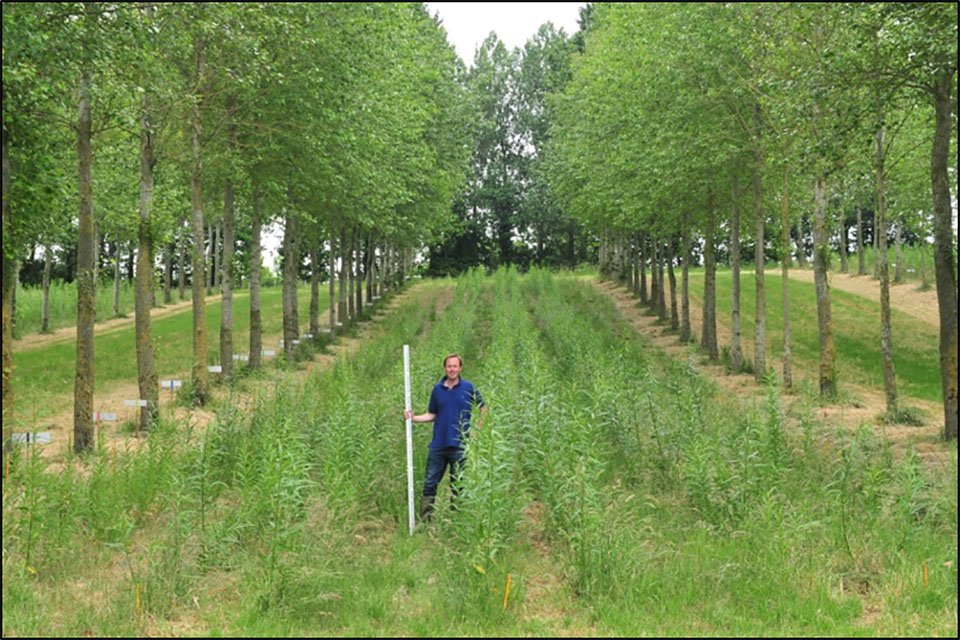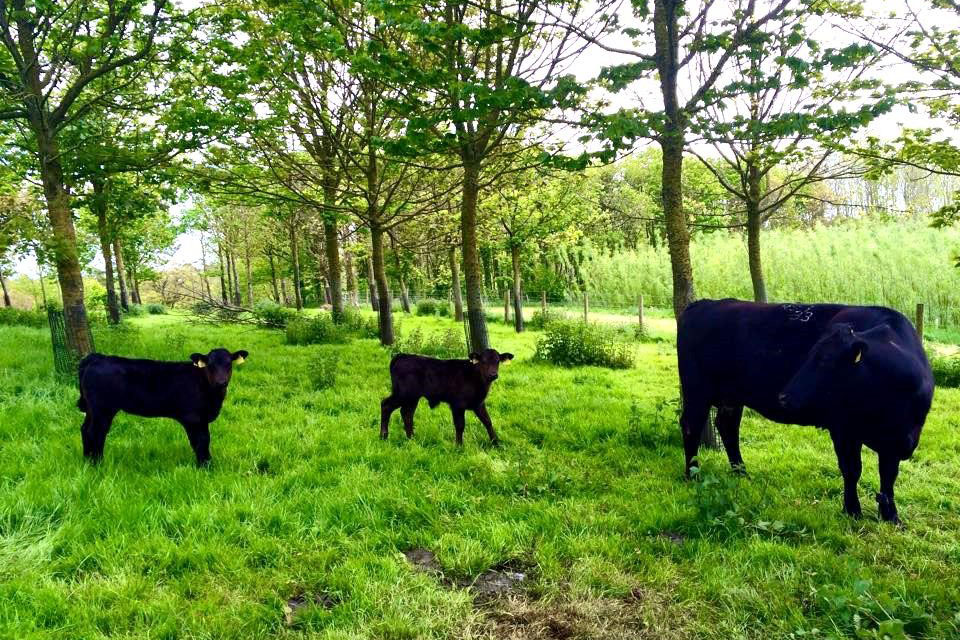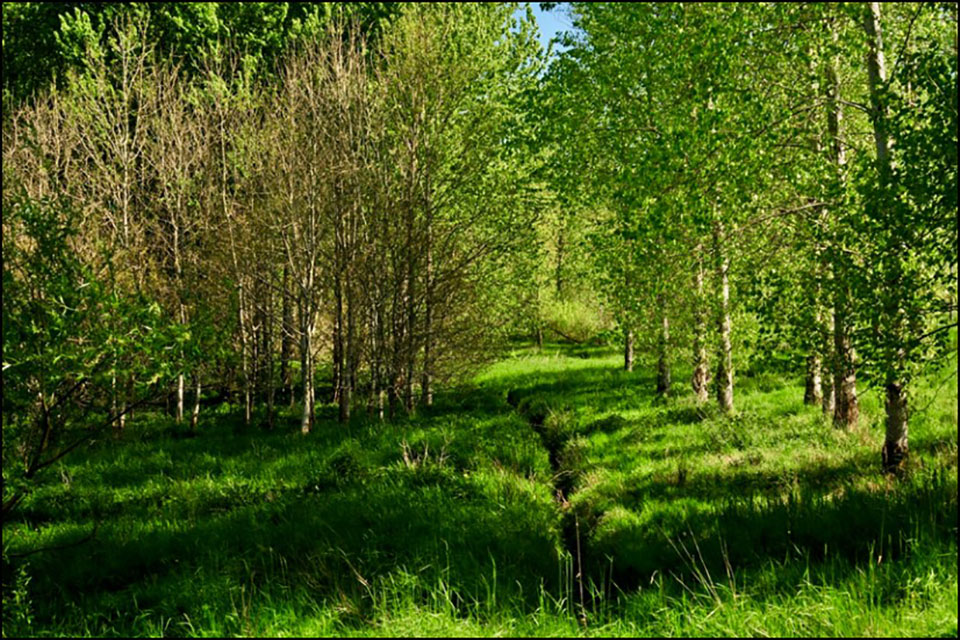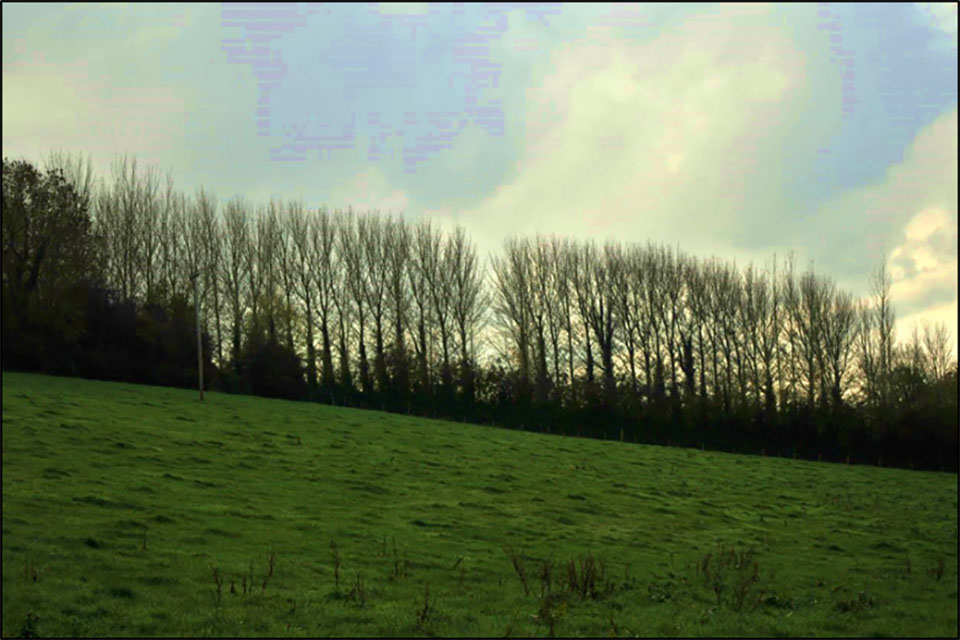HowAgroforestry agroforestryand works with the Basic Payment Scheme
AgroforestryAn optionsexplanation (treesand plantedexamples withof agriculture)some agroforestry options that are compatible with the Basic Payment Scheme (BPS).
Applies to England
Introduction
When the Basic Payment Scheme (BPS)(BPS) was introduced, the Rural Payments Agency (RPA) stated that grazed woodland was no longer eligible for payment.
This has led to some confusion that BPS is not compatible with agroforestry systems. However, some forms of agroforestry isare allowed underby the BPS scheme rules.
This guidanceAs issimplifications forare farmersbeing andmade landto managersBPS, it’s a good time to clarify these rules, especially considering plantingthe environmental benefits of having trees on theirfarms, agriculturalthe landgovernment commitment to planting new trees, and makesthe cleardesire howto support agroforestry worksthrough alongsideland themanagement BPS rules.schemes.
The benefits of agroforestry
Agroforestry is treewhere plantingtrees thatare is deliberately combined with agriculture on the same piece of land. It plays an important role in creating woodland on farms. It’s an essential connectionbridge between agriculture and forestryforestry, thatproviding couldtwo providepotential you with 2 sources of income from:to farmers:
- your
theagricultural products (livestock or crops) - any forestry-generated products (sawlogs, fuelwood, fruit and nuts)
This diversity will help reduce the risk from changes in the agricultural markets and help to stimulate and strengthen the rural economy.
Agroforestry also supports a number of goals in the government’s 25 Year Environment Plan and Clean Growth Strategy.Strategy. It provides wider ecosystem services, such as increased production potential, soil conservation, carbon capture, improved livestock welfare and increased biodiversity, and habitat creation. Agroforestry can also play an important role in climate change mitigation and adaptation.
What
The Committee on Climate Change estimates that agroforestry, specifically
silvoarablesystems-wherecropsgrowbetweentreessilvopastoralsystems-wherefarmanimalsgrazebetweentreeshedgecreation,
could result in carbon emissions savings of 5.9 MtCO2e per year by 2050. This represents approximately 13% of the BPStotal rulescurrent foremissions 2023from saythe agriculture sector. Research commissioned by Defra is also assessing the potential carbon savings from agroforestry.
The BPSgovernment rulesis forlooking 2023at a wide range of agroforestry practices including:
silvopasturesilvoarableriparianforestbufferswindbreaks/shelterbeltsforestfarming(includingorchards)hedgerowswithstandards
These practices are clearexplained thatin landmore growingdetail somebelow. typesThis range of treeagroforestry ispractices eligiblegives forfarmers BPS,flexibility whateverwith theiroptions density.and Awill numberensure the environmental sustainability of treeagricultural varietiesland.
What the ‘Basic Payment Scheme: rules for 2022’ say
The scheme rules are clear that land growing some types of tree is eligible for BPSBPS, inhowever agroforestrydensely systems.grown. SeeIn the sections:sections and subsections
- ‘What land is eligible for BPS’
BPS’ - ‘Permanent crops’
- ‘Short rotation coppice’
- ‘List of eligible crops’
crops’,
a number of tree varieties are clearly eligible. These trees could be used in agroforestry systems.
The scheme rules are also clear that land supporting any variety of tree can be eligible if certain conditions are met. The ‘List of Features’ includes the row ‘Trees’ which states:
“Trees‘Trees are eligible if they areare:
a)individualtreeswithintreesanoragriculturalparcel;b)(of2amaximumoftwoonan agricultural parcel.Groups
parcel;c)groupsof trees on an agricultural parcel,parcelwhetherthatnextarenotadjacentboundary;or not, are eligible if:I.(thisasconditionismetwhereitissuitableforoflivestock);II.land.
and
All other or
d)onanagriculturalparcelthatadjacenteligibletoforaagroforestryboundaryunderand;I.theBPS.Areas
areaofunderneathlandtheset-asidecanopyisusedagriculturalcreationactivityunder(thisagri-environmentconditionschemesisormetawherenationalitwoodlandisschemesuitablemayforbecultivationeligibleorgrazingoflivestock);II.unsuitableconditionsforarecultivation,met.theSchemesentireinclude:areaundercanopyForest- Changing
isLandscapeaccessibleScheme - Woodland
toCarbonfarmFundanimalsforgrazing;and - any
III.Nature4moreClimatethanFund50%woodlandofcreationtheschemearea(suchunderneathastheEnglandtreeWoodlandcanopyCreationisOffer)”coveredbygrasses,otherherbaceousforageorarableland.’
IfSo, if land containing trees meets thesethe criteria,criteria yourabove, eligibility for BPS iswould not affected.be affected by the trees.
The schemeguidance rules also statestates that under certain agri-environment and woodland creation schemes,schemes trees may be eligible for BPS.BPS. The rules state in the section ‘What land is eligible for BPS’:BPS’:
“Land‘Land is also eligible if it was used to claim for the Single Payment Scheme (SPS) in 2008 and has become non-agricultural under certain options in other agri-environment and woodland maintenance agreements and is still covered by those agreements.”agreements.’
The rules for agricultural land, under the section ‘Applying for BPS on land in agri-environment and woodland schemes’ state:
“Land‘Land included in an agri-environment scheme remains eligible for BPS if it continues to be:
- ‘agricultural’ land (permanent grassland, arable land or permanent crops)
crops);and - used primarily for an ‘agricultural activity’ throughout the calendar year
year;and is16May 20232022
YouAgri-environment canfield stillmargins, declarebuffer understrips, thefield maincorners, BPSbeetle landbanks, useand codeother forareas yournot landpermanently parcel:
- agri-environment
dividedfieldfrommargins - buffer
thestrips - field
restcorners - beetle
ofbanks - other
theareaslandnotparcelpermanentlycandividedcontinuefromtobedeclaredundermainofBPSlandusecodefor
The rules for non-agricultural land in the section ‘Non-agricultural land in agri-environment or woodland schemes’ state:
“If‘If the agri-environment or woodland scheme management requirements result in the land being taken out of agricultural use, it will normally become ineligible for BPS from the beginning of the agreement, even if required non-agricultural management activity has not yet started. The land should be declared on the BPS 20232022 application under an appropriate non-agricultural land use code.
Exceptionally, land that has been taken out of agricultural use under an agri-environment or woodland scheme will remain eligible for BPS if both conditions 1 and 2 apply:if:
- It
itwas used with entitlements to claim the Single Payment Scheme (SPS) in 2008.2008;and - It
itis managed under one of the relevant agri-environment and woodland options.options(Refer to the tables in the ‘Non-agriculturaltablelandbelow,in agri-environment or woodland schemes’ section of the BPS 2023 – scheme rules.) Or it is declared under a nationally funded woodland creation scheme including the National Forest Changing Landscape scheme, the Woodland Carbon Fund, the HS2 Woodland Fund and any Nature for Climate Fund woodland creation scheme (such as the EnglandHS2Woodland Creation Offer).Fund.
It only remains eligible for BPS while it remains in the agri-environment or woodland scheme option.”option.’
Types of agroforestry that may be compatible with the BPS scheme rules
WhileWhilst there are a number of agroforestry systems, the following may be compatible with the scheme rules on ‘trees in a line’ and ‘groups of trees’. Where BPS eligibility conditions are met, the associated land will be eligible for BPS payment.payment:
Silvoarable (trees and crops)
Trees that are planted at wide spacings and intercropped with a cereal or bioenergy crop.

Silvopasture (trees and livestock)
Trees that are combined with forage grassland and livestock production.

Riparian forestForest bufferBuffer
Trees that are planted between agricultural land and watercourses such as streams, rivers and lakes to act as buffers to protect the water quality.

Windbreak or shelterbeltWindbreak/Shelterbelt
Trees that are planted in a linear format on the edge of a field to reduce wind speed, protect crops and livestock and reduce erosion.

Woodland creation
Agricultural land that is taken out of production and planted with trees for woodland creation under a Rural Development Programme for England or nationally funded scheme may remain eligible for BPS. Theprovided the additional eligibility conditions set out in the BPS guidance willcan need to be met.
Grants that may be available for supporting agroforestry
Countryside Stewardship offers funding to farmers and land managers to protect and enhance the natural environment.environment, in support of a number of government and Defra objectives. Funding is available for a range of land management and capital works including tree and woodland management and planting of new trees.
The EnglandNature Woodlandfor CreationClimate Offerfund (EWCO) iswill develop a grantnew scheme,English managedwoodland bycreation theoffer Forestrywhich Commission. It will helpaim to meetstreamline and improve the government’sWoodland commitmentCreation toPlanning atGrant least(WCPG), trebleWoodland treeCarbon plantingFund rates(WCF) inand EnglandCountryside byStewardship theWoodland endCreation ofGrant this(CSWCG). parliament.Agroforestry EWCOhas supportsnot abeen rangespecifically ofaligned woodlandto creationany typesof includingthese but riparian bufferplanting andalready shelterbelts.exists Seeas below.
Thean Nature4Climateoption fundin willCSWCG developto asupport newwater Englishobjectives.
England woodlandWoodland creationCreation offer,Offer
The whichEngland willWoodland aimCreation toOffer streamline(EWCO) andis improvea the:
-
Woodland
flagshipCreationnewPlanninggrantGrantscheme,(WCPG) -
Woodland
administeredCarbonbyFundthe(WCF)Forestry(nowCommission,closed) -
Countryside
thatStewardshipwillWoodlandhelpCreationtoGrantmeet(CSWCG)the(nowgovernment’sclosed)
Agroforestrycommitment hasto notat beenleast specificallytreble alignedtree toplanting anyrates ofin theseEngland schemes,by butthe riparianend plantingof alreadythis existsparliament.
EWCO assupports ana optionrange inof CSWCGwoodland tocreation supporttypes waterincluding objectives.Riparian buffer and Shelterbelts.
EWCO
and riparianRiparian buffers
Additional contributions in EWCO are optional and will be available where the woodland’s location and design will deliver public benefits. One of these is riparianRiparian buffers –- available where woodland creation with native broadleaved species will improve riverbank habitats. It will provide the dappled shade that will improve aquatic ecology, and benefit wildlife dispersal, for example otter, along the corridors of habitat this creates.
Read about 3D buffer strips, which are designed to deliver more for the environment.
EWCO
and shelterbelts
EWCO supports action to address air pollution. Additional points are therefore available for creating shelterbelts designed to capture ammonia emissions from farm sources in locations where there is a potential risk of air pollution affectingimpacting a Site of Special Scientific Interest (SSSI).(SSSI) Here– where sensitive habitats or species could be impacted by direct toxic effects of ammonia, nitrogen deposition or acidification from ammonia emissions.
Check if you’re eligible to apply
Your application should cover a minimum area of one1 hectare with individual blocks of at least 0.1 hectare each. Blocks must have a minimum width of 20 metres (with the exception of riparian buffers and shelterbelts, which can have a minimum width of 10 metres).
Read more information about EWCO including how to apply for a grant.
FutureLooking environmental land management schemes
Our Environmental Land Management schemesscheme areis the base of our new agricultural policy. Environmental landLand managementManagement is founded on the principle of ‘public money for public goods’. YouFarmers and other land managers may enter into agreements to be paid for delivering a number of public goods, including mitigation of and adaption to climate change.
Where
Environmental toLand findManagement moreis information
Theabout Farmgiving Woodlandfarmers Forumand aimsland tomanagers facilitatean income for the generationenvironmental andpublic exchangegoods ofthey informationprovide. thatWe’re supportsconsidering besthow practicemore inenvironmentally-sustainable andfarming improvesapproaches, opportunitiesincluding foragro-ecological farmingapproaches withsuch trees.
Theas Defraagroforestry, farmingmay blogfit givesin youEnvironmental theLand up-to-dateManagement. informationWe’ll ondetermine in more detail what Environmental Land Management schemes.will pay for as we further develop the scheme. We are working with stakeholders and considering their feedback as part of this.
You
Where canto also find more information:information
Disclaimer
The information contained in this guidance relates and refers to the BPS scheme rules in the BPS‘Basic Payment Scheme: rules for 2023.2022’. The scheme rules may change,change so youfor shouldup-to-date checkinformation please refer to the BPSlatest rulesscheme forrules. 2023They forcontain details of where woodland makes the mostland up-to-dateineligible guidance.for BPS.
Last updated 14
-
Content updated for Basic Payment Scheme 2023.
-
Updated to make specific to BPS 2022. England Woodland Creation Offer (EWCO) section added.
-
Dates updated for the 2021 scheme year.
-
First published.
Update history
2023-03-14 10:00
Content updated for Basic Payment Scheme 2023.
2022-03-15 07:57
Updated to make specific to BPS 2022.England Woodland Creation Offer (EWCO) section added.